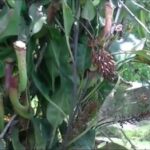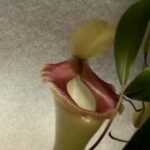As an Amazon Associate, this site earns commissions from qualifying purchases. For more details, click here.
Found throughout Thailand, Indonesia, Singapore, Malaysia and New Guinea, nepenthes ampullaria is unique among tropical pitcher plants because it is a detritivore, not carnivore. These plants also have some particular care requirements, but nothing too difficult for a beginner to handle.
Nepenthes ampullaria may be grown in a terrarium with partially shaded light and high humidity, 70% and up. The temperature range has to be 75-80 F daytime and no lower than 60 F at night. Perlite and peat can be used as soil.
Nepenthes Ampullaria Care Sheet
| Soil | Equal parts perlite and peat, keep the soil moist |
| Water | Purified, distilled or rainwater |
| Light | Partial light, grow bulb lights are fine |
| Food | Small bugs, fish pellets, freeze dried mealworms |
| Temperature | 75-80 F (23-26 C) |
| Humidity | At least 70% |
| Dormancy | Not required |
| Propagation | Seeds, cuttings |
Soil
Tropical pitcher plants like n. ampullaria prefer a bog-like environment so perlite and peat moss will be fine. You can also add long fiber sphagnum (LFS) at the top for better water retention. Ratio should be 1:1 for peat and perlite and bits of LFS.
Nepenthes ampullaria is not choosy about soil and adapts well to different mixes. The LFS, peat and perlite combo works fine in most cases. However peat and LFS might break down if not mixed properly. As an alternative there is red clay soil and live sphagnum.
You can combine pine bark with live sphagnum. N. ampullaria likes its soil wetter than most other nepenthes. However you need to watch out for root rot. If the soil gets too damp it will damage the roots and cause serious problems.
If you are a beginner, there are premixed potting soil available. If it contains any of the media mentioned here, it should work for your n. ampullaria. Do not add fertilizer to the soil because it will cause serious damage and could even be fatal.
Pot Container
A terrarium or aquarium is best for nepenthes ampullaria. You may also need a humidifier, artificial light source and heat source.
You also have to consider the terrarium size. A young n. ampullaria has 3-4 inch leaves. After 9 months or so those leaves will double in size. A healthy nepenthes ampullaria might need up to two square feet of space. In most cases though a product like the Yimorence V Terrarium is going to be enough.
It can be difficult to grow outdoors unless you can replicate its natural environment. If you are in the northern hemisphere, this plant is best cultivated indoors or any enclosed growth chamber.
Can you grow this nepenthes on a sunny windowsill? Yes it is possible, but it might be challenging. These pitcher plants like it warm with high humidity and partially shaded light. If the conditions are not favorable the plant will struggle to grow. By keeping your n. ampullaria in a terrarium, you can control the heat, humidity and lighting.
Water
Watering needs to be handled carefully. N. ampullaria prefers a humid environment and the soil needs to be more moist than usual. Other pitcher plants like nepenthes mirabilis also like it damp. With n. ampullaria it has to be a little bit more without overwatering.
Nepenthes ampullaria has to be watered from the top. Use the tray method sparingly because it might lead to root rot. Use only distilled or rainwater.
This is why sphagnum moss is often used because it retains water well. To keep it simple, water from the top until the potting media gets damp. Water again as soon as the soil shows signs of dryness
Misting can help increase moisture. Use a spray bottle and mist freely. This will really come in handy during summer when the temperature goes up.
If you really want to try the tray method, use only 0.5 inches of water. If you have a healthy nepenthes it should be fine. In most cases however it is better to stick with overhead watering.
Light
In nature these pitcher plants grow in forests with partial to heavy shading. There is some debate whether normal sunlight or partially covered is better. There is an argument to be made for both as some variants seem to thrive in different conditions.
While nepenthes ampullaria can grow in normal light, it flourishes in partially shaded conditions. Use a 60W CFL bulb or the EcoSmart Lght Bulbs and set it about 8 inches away from the plant.
N. ampullaria has several natural hybrids, some of which prefer more light than others. Check the care instructions that came with your plant. If there is none, keep the plant in partial shade and observe how it responds.
As explained earlier, these lowland nepenthes grow best in a terrarium. Get a 60W light bulb and let it serve as light for the plant. Make sure there is high humidity in the terrarium and the temperature, soil and water are set properly. Under these conditions a nepenthes ampullaria will grow quickly.
Some growers use more powerful lights, up to 300 watts or more. A healthy nepenthes does not need that much but it depends on the environment. Start with 60 watts and see what happens. If the plant looks faded, increase the wattage until the nepenthes develops vibrant colors.
Temperature
Just like nepenthes ventricosa, the environment affects how well nepenthes ampullaria can handle fluctuating temperature. A healthy plant will be more resistant to heat and cold than a sickly one. Conversely, a sick nepenthes will struggle no matter what the temperature is.
The optimum temperature is 75-80 F (23-26 C) in the day and 60 F (15.5 C) at night. Some variants prefer higher daytime temperature up to 90 degrees. There are also some species that thrive in warm nights around 80 degrees.
If your nepenthes is in a terrarium, make sure there is good airflow and ventilation. Otherwise it will get too hot inside and weaken the plant. If your nepenthes is on a sunny windowsill, the heat, light and humidity have to be close to the ideal range as stated here.
Humidity
Nepenthes ampullaria prefers high humidity, up to 70% or more. Do not let the humidity drop to less than 50% for more than a few hours.
If you can keep it at 70%+ most of the time, the nepenthes will grow healthy. If the humidity in your area is always high – around 7%0 or more – you can probably get rid of the terrarium.
The ideal setup for n. ampullaria is someplace warm and very humid. 70% is fine, but 85% or higher is even better.
If humidity is low, misting will help. If your nepenthes is robust you can sit it in half an inch of water. Do this only during very hot days. If you are going to use the tray method, add a fogger to improve humidity. You can also use a humidifier and a fan to improve ventilation.
Nutrition and Feeding
Being a detritivore, nepenthes ampullaria consumes organic material from leaves. In nature, matter from leaves that fall into its pitchers are absorbed as nutrients.
The best food for nepenthes ampullaria is fertilizer. Add 1/4 teaspoon of Maxsea 16-16-16 into a gallon of water. Mix well. Use an eyedropper and place a couple of drops into a few pitchers. Do this every two weeks.
It might take some time, but the fertilizers will speed up growth. Too much is harmful so watch how the plant responds. Do not feed it other food if you are giving it fertilizer regularly.
With enough fertilizer your nepenthes may flourish in low humidity, even at 30-40%. But for the best results you should aim for 70% or higher. This will lead to quicker growth and healthier pitchers.
Dormancy
Nepenthes ampullaria does not have a dormancy period. Do not expose this plant to extreme cold. As much as possible keep it in the same temperature and humidity all the time.
You can leave n. ampullaria outdoors if the conditions are ideal. Otherwise it is easier to grow indoors in a terrarium. This way you do not have to move the plant back and forth when the seasons change.
Since n. ampullaria does not go through dormancy, its seeds do not require stratification. Just place the seeds on moist long fiber sphagnum and set humidity to 80% minimum. Germination will commence in 2-3 weeks.

My fascination with carnivorous plants began many, many years ago with Venus Fly Traps. Now I am more than happy to impart what I know with other enthusiasts and those who are curious about meat eating plants.



